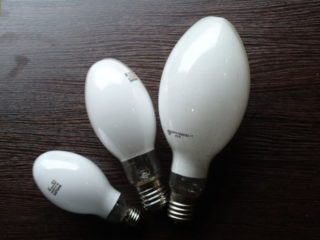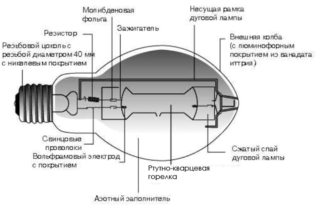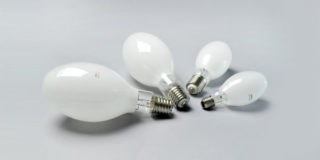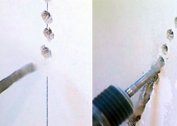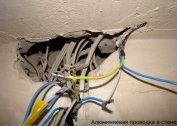Lighting devices are used to create lighting in homes, industrial buildings, on the street, in museums and other fields. One of these products for creating artificial light is a DRL lamp. This is a device that belongs to the category of mercury discharge lamps. DRL has a different way of working from other light sources, which should be dealt with before buying or when choosing analogues.
What is a DRL lamp
First of all, it is worth sorting out the name, because it is on it that the master determines the characteristics and working conditions. The acronym DRL can be decrypted as follows:
- D - type of ignition. The source lights up under the influence of an electric arc, which is formed when a voltage is applied.
- P - mercury.
- L - the conversion of ultraviolet light into visible light is carried out using a phosphor.
Also in the marking after the letters you can see a digital three-digit code. It shows the power the lamp is designed for. On sale you can find appliances with a power of 150 W, 200 W, 250 W, 400 W and other load values. In everyday life, 250 W and 400 W bulbs are usually used.
Design features and principle of operation
The DRL lamp has a standard design for discharge lamps. It consists of three parts - a glass flask, a socle and a burner. Electrodes and a limiting resistor are located inside the burner. Air is pumped out in the flask, after which it is filled with nitrogen. A phosphor is applied on the inner surface. The burner contains a mixture of inert gases and mercury. The lamp bases are different, the standard is E14 and E27.
The DRL bulb works similarly to a discharge lamp. When voltage is applied to live parts, a glow discharge occurs. As a result, electrons and ions accumulate and the inside of the tube is heated. Mercury evaporates, a glow discharge becomes an arc. As the amount of mercury vapor increases, the brightness of the glow increases. The resulting ultraviolet light enters the phosphor. When passing through it, it is converted into visible radiation.
Subject to operating conditions, the time for turning on the lamp and its output to the declared parameters is about 4 minutes. With increasing temperature, this time decreases.
Types of DRL lamps
DRL lamps have several modifications that have different specifications and operating conditions.
- Classic DRL lamp. Standard modification. The disadvantages of the model include high heating during operation, sensitivity to voltage changes, a long time to reach optimal performance. The most common are the DRL 250 lamp and DRL 400. The luminous flux of the DRL 250 allows you to use the device in home lighting.
- DRV or DRVED - arc mercury tungsten (erythema tungsten) lamp. The product starts without the use of a throttle and has improved indicators of light emission.
- DRLF - unlike a standard lamp, has improved characteristics due to the coating of the bulb with reflective material.
All listed types can replace each other.
Specifications
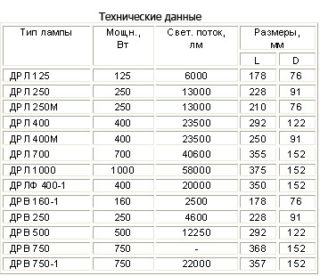 Any lighting product must have information about the power. In DRL lamps, it is indicated in the marking.
Any lighting product must have information about the power. In DRL lamps, it is indicated in the marking.
Also important indicators are:
- Light flow. From this value, how many light bulbs are needed to create the necessary level of illumination per unit area.At DRL 400, the luminous flux is 18,000 lm.
- Estimated time of operation. Shows how many hours the light bulb can work in the declared conditions.
- Basement Sets the parameters for a chandelier or other lamp.
- Sizes.
- Supply voltage.
All these parameters, as well as operating conditions, can be found in the documentation for the lamp.
Application area
DRL lighting devices are actively used as a source of artificial light in external and internal illumination: for illumination of carriageways, highways, parks and squares, as well as industrial premises and industrial workshops with a capacity of several megawatts.
DRV products are used in the same facilities as DRL, as well as in lighting agricultural enterprises that grow various crops in insulated soil. It can be greenhouses, greenhouses, gardens.
Lamp connection
DRV modification does not need a throttle for connection. The bulb can be directly connected to the mains. The throttle lamp connection scheme requires a ballast. This device provides regulation of the current within a predetermined range. Using a throttle, you can eliminate the burnout of the light source and create a mode to start it. The inductor also corrects the operation of the device by stabilizing the operating voltage supplied to the contacts.
There are two types of chokes - independent and built-in. They are installed in various designs of luminaires and depend on the installation location of the ballast (PRA).
The following parameters affect the choice of ballast model:
- light bulb electric power;
- operating current and voltage;
- winding temperature;
- the most admissible heating;
- greatest power loss;
- Power factor.
The most common breakdown in gas-discharge drl lamps is associated with ballast malfunctions. The device will not light up during operation. For this reason, it is important to be able to check the throttle for operability. This can be done using a multimeter that will check the integrity of the windings and the presence of inter-turn circuit.
Another way of checking is by using an incandescent lamp of the same power, connected in series with the circuit. When the product is in good condition, the light will turn on at half light or blink. In the absence of light, damage to the winding can be judged. Too bright light indicates the presence of an inter-turn short circuit.
Advantages and disadvantages
DRL lamps are quite popular light sources. This is due to their positive qualities, which include:
- long term of operation;
- compactness;
- standard socles;
- good luminous flux;
- reduced power consumption.
 Disadvantages limiting the use of light bulbs:
Disadvantages limiting the use of light bulbs:
- Susceptibility to voltage changes.
- The presence of pulsations that are harmful to human health.
- Long ignition time.
- The presence of harmful ultraviolet light.
- Lamp modifications have lower efficiency and service life.
- The presence of harmful components in the composition.
- Fragility. The glass flask is easy to break, so you need to work with the device carefully.
- The complexity of disposal. Mercury and other harmful substances contained in the appliance cause the light bulb to not be disposed of with household waste. It is disposed of at special collection points.
Despite all the advantages of such light sources, most consumers of electricity switch to LED analogues. They are safer, have a longer life and improved performance. LED lamp e40 analog DRL 400 has almost replaced the gas-discharge product.
In 2014, the Russian Federation signed the Minamata Convention. According to this document, starting from 2020, the production, use, export and import of mercury products should be discontinued.Gas-discharge devices fall under the ban; therefore, it is now recommended to think about replacing the DRL 400 with LED lamps with improved characteristics and a high degree of environmental friendliness. This applies to both home and industrial and street lights.
